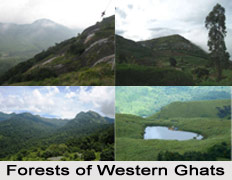 Forest vegetation in West India especially in the Western Ghats Mountain Range in India is much influenced by the kind of climatic and geographical conditions found existing in this part of the country. Conspicuous forest vegetation in this area comprises tropical thorn forests and tropical dry deciduous forests.
Forest vegetation in West India especially in the Western Ghats Mountain Range in India is much influenced by the kind of climatic and geographical conditions found existing in this part of the country. Conspicuous forest vegetation in this area comprises tropical thorn forests and tropical dry deciduous forests.
Nature of the Trees of West India
Most of the tropical thorn forest is on flat ground or on low undulating hills and plateaus. Thorn forests are open low tree stands with predominance of thorny, usually hardwood, species. Trees usually have short boles. The crowns are low branching. They rarely meet. The usual height of the trees is between 6 to 9 metres. There is seen a mixture of species in the forests. The lower story is ill- defined. It consists of smaller trees and large shrubs with Xerophytic characters. Spiny low shrubs, too, occur. A thin layer of grass growth appears during the moist season. The oil is rather bare during drier months. Climbers are less. They, too, have Xerophytic character.
Concentration of Tropical Thorn Forests and Dry Deciduous Forest
Tropical thorn forests and dry deciduous forests are found in Rajasthan (Bikaner, Jaipur, Chittorgarh, Jodhpur, Udaipur, Jhunjhuner, Jaisalmer etc.), Gujarat (Kutch, Sasan, Dwarka etc.), Haryana (Hissar, Jhumpa). Genus Acacia is very characteristic. A number of species (A. catechue, A. leucophloea, A. arabica, A. planifrons) occur. Several other genera allied to Acacia are also characteristic. Fleshy Euphorbias are usually present. Species met are E. tirrucalli, E. antiquorum, E. niviulis. Euphorbias may occasionally form a conspicuous constituent of the vegetation. Capparis is also a typical genus of thorn forests. Species met are C. divaricata, C. decidua etc. Ziziphus, Mimosae, Anogeissus, Albizzia, Azadirachta are other important genera present.
Desert Regions and Tropical Thorn Forests and Dry Deciduous Forest
Mention needs to b e made here of the desert dune scrub encountered in Rajasthan and Haryana. It is a very open and stunted formation of trees and bushes covering only a small proportion of the soil. The trees are thorny. All vegetation is conspicuously Xerophytic.
Climate of Tropical Thorn Forests and Dry Deciduous Forest
The climate is that of tropical thorn forests. Dry, sandy and unstable soil gets wind blown into typical dune forms. Major species seen are Prosopis spicigera, Acacia arabica, Tamrix aphylla, Salvadora oleoides, Calatropis gigantica, Ziziphus spp, Balanitis aegyptica, Capparis decidua etc. Grasses include Erianthus, Munja, Aristida spp, Eragrostis spp, Cynodon dactylon etc.
Regions of Forest Vegetation in West India
| Name of the Peak | Location of Forest Vegetation in West India |
| Anaimudi | Eravikulam National Park, Kerala |
| Mannamalai | Idukki, Kerala |
| Meesapulimala | Idukki, Kerala |
| Doddabetta | Nilgiris Mountain Range, Tamil Nadu |
| Kolaribetta | Mukurthi National Park, Tamil Nadu |
| Mukurthi | Mukurthi National Park, Tamil Nadu |
| Vandaravu Peak | Palani Hills Wildlife Sanctuary and National Park, Tamil Nadu |
| Kattumala | Eravikulam National Park, Kerala |
| Anginda peak | Silent Valley National Park, Kerala |
| Vavul mala | Vellarimala, Kerala |
| Kodaikanal | Kodaikanal, Tamil Nadu |
| Chembra Peak | Wayanad, Kerala |
| Elivai Mala | Palakkad, Kerala |
| Banasura Peak | Wayanad, Kerala |
| Kottamala | Periyar National Park, Kerala |
| Mullayanagiri | Chikmagalur, Karnataka |
| Devarmala | Achenkovil, Kerala |
| Baba Budangiri | Chikmagalur, Karnataka |
| Kudremukh | Chikmagalur, Karnataka |
| Agasthyamala | Thiruvananthapuram, Kerala |
| Biligiriranga Hills | Chamarajanagar, Karnataka |
| Velliangiri Mountains | Coimbatore, Tamil Nadu |
| Tadiandamol | Kodagu, Karnataka |
| Kumara Parvata | Dakshina Kannada, Karnataka |
| Pushpagiri | Pushpagiri Wildlife Sanctuary, Karnataka |
| Merthi Gudda | Basarikatte / Hornadu, Karnataka |
| Kalsubai | Ahmednagar, Maharashtra |
| Brahmagiri | Kodagu, Karnataka |
| Kote Betta | Kodagu, Karnataka |
| Salher | Nashik, Maharashtra |
| Madikeri | Kodagu, Karnataka |
| Dhodap | Nashik, Maharashtra |
| Himavad Gopalaswamy Betta | Chamarajanagar, Karnataka |
| Taramati | Ahmednagar, Maharashtra |
| Torna Fort | Pune, Maharashtra |
| Purandar fort | Pune, Maharashtra |
| Raigad fort | Raigad, Maharashtra |
| Kodachadri | Shimoga, Karnataka. |
| Paital Mala | Kudiyanmala, Kerala |















